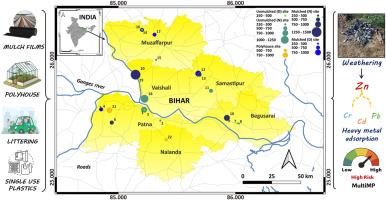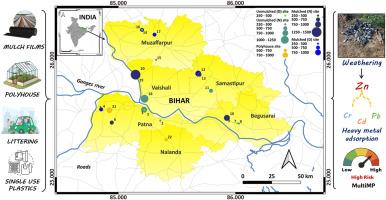Agronomic practices and road proximity drive plastic pollution in agricultural soils: Insights from Bihar, India on weathering, elemental association, and ecological risk
IF 7.3
2区 环境科学与生态学
Q1 ENVIRONMENTAL SCIENCES
引用次数: 0
Abstract
The widespread use of plastics in agriculture, particularly through mulching and polyhouse practices, has intensified concerns over soil contamination. However, limited research has addressed how spatial factors and agronomic practices, such as proximity to roads and mulching, influence macroplastics (MaP) and microplastics (MP) distribution in agricultural soils, particularly in India. This study assessed plastic contamination across 22 sites in six districts of Bihar, revealing mean MaP concentrations of 7.5 ± 3.6 particles kg−1 soil (d.w.) and MP levels ranging from 150 to 1460 particles kg−1 soil. MP concentrations were highest in mulched fields near roads (803 ± 371 particles kg−1), followed by distant mulched sites (657 ± 143 particles kg−1). Elevated levels were observed even in unmulched near-road fields (494 ± 327 particles kg−1), while the unmulched, distant fields (335 ± 76 particles kg−1) had the least contamination, indicating a combined influence of agricultural practices and road proximity. Polymer characterization revealed four types of MPs (PP > PE > PET > PS), with PE and PP accounting for over 95 % of the total. Weathering assessment via carbonyl index (CI) showed significantly higher values in MPs than MaPs, and field-extracted mulch films exhibited reduced contact angles relative to pristine films, indicating increased surface oxidation and hydrophilicity. Furthermore, MPs were found to adsorb multiple heavy metals, including Pb, Cu, Cr, Cd, Co, As, and Zn, highlighting risks of co-contaminant transport. Based on the MultiMP framework, all field types were classified as high-risk for MPs related impacts. These findings emphasize the need for sustainable plastic use in agriculture and call for targeted policy measures, including improved disposal practices and adoption of biodegradable alternatives, to mitigate long-term soil degradation and ecological harm.


农艺实践和道路邻近驱动农业土壤中的塑料污染:来自印度比哈尔邦的风化,元素关联和生态风险的见解
塑料在农业上的广泛使用,特别是通过覆盖和混合工场的做法,加剧了人们对土壤污染的担忧。然而,有限的研究已经解决了空间因素和农艺实践,如靠近道路和覆盖,如何影响农业土壤中的宏观塑料(MaP)和微塑料(MP)分布,特别是在印度。该研究评估了比哈尔邦6个地区22个地点的塑料污染,显示平均MaP浓度为7.5±3.6颗粒kg-1土壤(d.w), MP水平为150至1460颗粒kg-1土壤。靠近公路的地膜地的MP浓度最高(803±371粒kg-1),远处地膜地次之(657±143粒kg-1)。即使在未覆盖的近公路农田中也观察到污染水平升高(494±327颗粒kg-1),而未覆盖的远农田(335±76颗粒kg-1)的污染程度最低,表明农业实践和靠近道路的综合影响。聚合物表征揭示了四种类型的MPs (PP >;体育比;宠物比;PS),其中PE和PP占总量的95%以上。通过羰基指数(CI)进行的风化评估显示,MPs的值明显高于map,而田间提取的地膜与原始地膜相比,接触角减小,表明表面氧化性和亲水性增强。此外,MPs还吸附了多种重金属,包括Pb、Cu、Cr、Cd、Co、As和Zn,突出了共污染物运输的风险。基于MultiMP框架,所有油田类型都被归类为与MPs相关的高风险影响。这些研究结果强调了在农业中可持续使用塑料的必要性,并呼吁采取有针对性的政策措施,包括改进处理做法和采用可生物降解的替代品,以减轻长期的土壤退化和生态危害。
本文章由计算机程序翻译,如有差异,请以英文原文为准。
求助全文
约1分钟内获得全文
求助全文
来源期刊

Environmental Pollution
环境科学-环境科学
CiteScore
16.00
自引率
6.70%
发文量
2082
审稿时长
2.9 months
期刊介绍:
Environmental Pollution is an international peer-reviewed journal that publishes high-quality research papers and review articles covering all aspects of environmental pollution and its impacts on ecosystems and human health.
Subject areas include, but are not limited to:
• Sources and occurrences of pollutants that are clearly defined and measured in environmental compartments, food and food-related items, and human bodies;
• Interlinks between contaminant exposure and biological, ecological, and human health effects, including those of climate change;
• Contaminants of emerging concerns (including but not limited to antibiotic resistant microorganisms or genes, microplastics/nanoplastics, electronic wastes, light, and noise) and/or their biological, ecological, or human health effects;
• Laboratory and field studies on the remediation/mitigation of environmental pollution via new techniques and with clear links to biological, ecological, or human health effects;
• Modeling of pollution processes, patterns, or trends that is of clear environmental and/or human health interest;
• New techniques that measure and examine environmental occurrences, transport, behavior, and effects of pollutants within the environment or the laboratory, provided that they can be clearly used to address problems within regional or global environmental compartments.
 求助内容:
求助内容: 应助结果提醒方式:
应助结果提醒方式:


